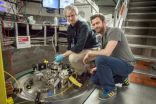(Press-News.org) As experts debate the slow response to the Ebola outbreak in West Africa and call for better international coordination, a new analysis estimates that $22 billion was spent on global health aid in 2013, yet only a fifth of this went toward such global imperatives as research on diseases that disproportionally affect the poor, outbreak preparedness and global health leadership.
The analysis, by Dean Jamison, PhD, a global health economist at UC San Francisco (UCSF); Lawrence Summers, PhD, a former US Treasury Secretary now at Harvard University; and researchers at SEEK Development in Berlin and the Karolinska Institutet in Stockholm, is the first in-depth study of how donor funding is spent on global versus country-specific functions of health. Global functions are those that address transnational issues by supporting global public goods such as research and development (R&D), managing cross-border risks, such as pandemic preparedness, and fostering leadership and stewardship. It was published Monday, July 13, 2015, in The Lancet and comes as world leaders gather at the Financing for Development Conference this week in Addis Ababa, Ethiopia, to discuss how the United Nations' new development goals should be financed. These new goals, called the Sustainable Development Goals (SDGs), are to be adopted at the UN General Assembly meeting in September.
"We introduce a new definition of global health financing - one that includes additional public R&D spending for neglected diseases," said lead author Marco Schäferhoff, PhD, of SEEK Development in Berlin, Germany. "This expanded thinking has the potential to reshape how policy makers approach supporting health."
In all, the analysis found that just $4.7 billion went toward the global functions of health, which is far less than the authors said was needed. Experts have recommended investing $6 billion a year just on R&D for neglected diseases.
The analysis found that in 2013, donors invested less than $1 billion towards managing cross-border risks, although the World Bank has estimated the annual cost of building a pandemic preparedness system for low- and middle-income countries would be $3.4 billion alone.
Just before the Ebola outbreak in West Africa, WHO's budget for outbreak and crisis response was cut nearly in half from $469 million to $241 million. The authors said the recent approval of a $100 million emergency fund at WHO shows that world leaders have begun to recognize the need to address this funding gap. But donors spent only 3 percent of global health aid in 2013 on leadership and stewardship, and WHO's core budget continues to shrink.
The analysis shows that the vast majority of health aid, 79 percent, went to country-specific functions in global health - defined as aid sent directly to recipient countries for health service delivery and system strengthening.
The authors said that in the next couple of decades, there are likely to be significant changes to international health aid, as economic growth will allow more countries to increasing spending on domestic health services. The analysis found that 31 percent of country-specific aid is directed toward middle-income countries. The authors said the global community would better support health in middle-income countries by increasing the money available for global functions. This would help the world's poorest people, even if they live in a middle-income country too rich to qualify for aid. For example, the authors said, countries like China and India can benefit from bulk purchasing of commodities, lower drug prices and control of diseases like multi-drug resistant tuberculosis. India, alone, has a fifth of these cases around the world.
"We should be investing in global functions, like research and development and constraining transmission of drug-resistant disease strains across borders, because these investments will help poor people wherever they live," said Jamison, who is a senior fellow in Global Health Sciences at UCSF. "If aid must be cut, it should be for middle-income countries that can afford more domestic spending on health."
However, the authors said that donor countries should ensure that vulnerable populations in middle-income countries, such as ethnic minorities who suffer discrimination, refugees and people who inject drugs, continue to get support, since it may be difficult for many countries to withstand the political pressures against helping stigmatized groups.
Finally, the authors said health aid to the world's poorest countries must continue in the coming decades. Despite worldwide economic growth, there are still expected to be 22 low-income countries in 2035, compared to 36 in 2012. Many of these countries are fragile and too wracked with conflict to adequately attend to their people's significant health needs.
INFORMATION:
Other authors of the study include Sara Fewer, MPP, and Gavin Yamey, MD, of UCSF; Jessica Kraus, BA, and Emil Richter, MA, of SEEK Development; and Jesper Sundewall, PhD, of the Karolinska Institutet.
The study was funded by the Bill & Melinda Gates Foundation.
UC San Francisco (UCSF) is a leading university dedicated to promoting health worldwide through advanced biomedical research, graduate-level education in the life sciences and health professions, and excellence in patient care. It includes top-ranked graduate schools of dentistry, medicine, nursing and pharmacy, a graduate division with nationally renowned programs in basic, biomedical, translational and population sciences, as well as a preeminent biomedical research enterprise and two top-ranked hospitals, UCSF Medical Center and UCSF Benioff Children's Hospital San Francisco. Please visit http://www.ucsf.edu.
SEEK Development is a consulting group based in Berlin, Germany, dedicated to supporting and shaping human development globally. It provides specialized support to leading institutions in global health and development in the areas of strategy and policy, organizational evaluation and development, knowledge generation and advocacy. Please visit http://www.seekdevelopment.org.
Follow UCSF
ucsf.edu | Facebook.com/ucsf | Twitter.com/ucsf | YouTube.com/ucsf
ORLANDO, FL - Surgeries related to overuse elbow injuries, i.e. Tommy John Surgery, are more common among youth athletes than previously believed, according to research presented today at the American Orthopaedic Society for Sports Medicine's (AOSSM) Annual Meeting in Orlando, Florida.
"Our results showed that 15-19 year-olds accounted for 56.7 percent of the Ulnar Collateral Ligament Reconstruction (UCLR) or Tommy John surgeries performed in the U.S. between 2007-2011. This is a significant increase over time with an average increase of 9.12 percent per year," said lead ...
ORLANDO, FL - Athletes who've had lower extremity surgeries before going on to play in college, might be at a higher risk for another surgery independent of gender and sport, say researchers presenting their work today at the American Orthopaedic Society for Sports Medicine's (AOSSM) Annual Meeting in Orlando, FL.
"This is the first study to look at the relationship between precollegiate surgery and future injury requiring surgery in collegiate athletes. Our results suggest that athletes injured before college might be left with a functional deficit that puts them at ...
Nutrition support professionals who are well-versed in proper documentation of malnutrition diagnoses in hospital patients can help ensure that hospitals receive maximum funding for patient care according to a new review.
The review, recently published in Nutrition in Clinical Practice (NCP), a peer-reviewed, interdisciplinary journal of the American Society for Parenteral and Enteral Nutrition (A.S.P.E.N.) that publishes articles about the scientific basis and clinical application of nutrition and nutrition support, found that proper documentation and coding of malnutrition ...
ORLANDO, FL - Patients treated surgically for a hamstring rupture demonstrated better results than those treated only with therapy, according to a study presented today at the American Orthopaedic Society for Sports Medicine's (AOSSM) Annual Meeting in Orlando, FL.
"Overall, patients in this study treated with surgery had a trend towards better lower extremity function as well as a higher likelihood of returning to re-injury activities than those treated non-surgically," commented corresponding author Joshua Olsen, MD, from the New England Baptist Hospital. "Most notably, ...
ORLANDO, FL - Outcomes following the arthroscopic repair of rotator cuff tears in older athletes appears to be successful a majority of the time, according to research presented today at the American Orthopaedic Society for Sports Medicine's (AOSSM) Annual Meeting in Orlando, Florida.
"Seventy-seven percent of our patients who had an arthroscopic repair of a full thickness rotator cuff tear, were able to return to their sport at a similar level of intensity," said lead author, Peter Millett, MD, MSc, from the Steadman Philippon Research Institute in Vail, Colorado.
Forty-nine ...
OAK RIDGE, Tenn., July 10, 2015 -- Groundbreaking work at two Department of Energy national laboratories has confirmed plutonium's magnetism, which scientists have long theorized but have never been able to experimentally observe. The advances that enabled the discovery hold great promise for materials, energy and computing applications.
Plutonium was first produced in 1940 and its unstable nucleus allows it to undergo fission, making it useful for nuclear fuels as well as for nuclear weapons. Much less known, however, is that the electronic cloud surrounding the plutonium ...
Five billion years ago, a great disturbance rocked a region near the monster black hole at the center of galaxy 3C 279. On June 14, the pulse of high-energy light produced by this event finally arrived at Earth, setting off detectors aboard NASA's Fermi Gamma-ray Space Telescope and other satellites. Astronomers around the world turned instruments toward the galaxy to observe this brief but record-setting flare in greater detail.
"One day 3C 279 was just one of many active galaxies we see, and the next day it was the brightest thing in the gamma-ray sky," said Sara ...
NOAA's GOES-West satellite saw that Hawaii is in the middle of a triangle of tropical cyclones. Tropical Depression 02C formed over 700 hundred miles south-southeast of Hawaii on July 10.
There are three tropical cyclones in the Central Pacific Ocean and Hawaii is in the middle of them. On July 10, newborn Tropical Depression 01C was west of Hawaii, while newborn Tropical Depression 02C was south of the Big Island. Post-Tropical Depression Ela was fizzling northeast of Hawaii.
NOAA's GOES-West satellite provided an infrared image of the newborn depression that showed ...
NOAA's GOES-West satellite saw that Hawaii is in the middle of a triangle of tropical cyclones. Tropical Depression 01C formed hundreds of miles southwest of Hawaii on July 10.
There are three tropical cyclones in the Central Pacific Ocean and Hawaii is in the middle of them. On July 10, newborn Tropical Depression 01C was west of Hawaii, while newborn Tropical Depression 02C was south of the Big Island. Post-Tropical Depression Ela was fizzling northeast of Hawaii.
NOAA's GOES-West satellite provided an infrared image of the newborn depression that showed fragmented ...
An automated thermal detection system that can discern wild elephants from background and other animals in infrared images could save lives in parts of the world where the animals roam free and often enter villages and other human habitation, according to research published in the International Journal of Electronic Security and Digital Forensics.
Siva Mangai and colleagues at Karunya University, in Coimbatore, Tamil Nadu, India, explain how encounters between humans and elephants is a critical safety issue in the Western Ghats region of Tamil Nadu. "The movement of wild ...


